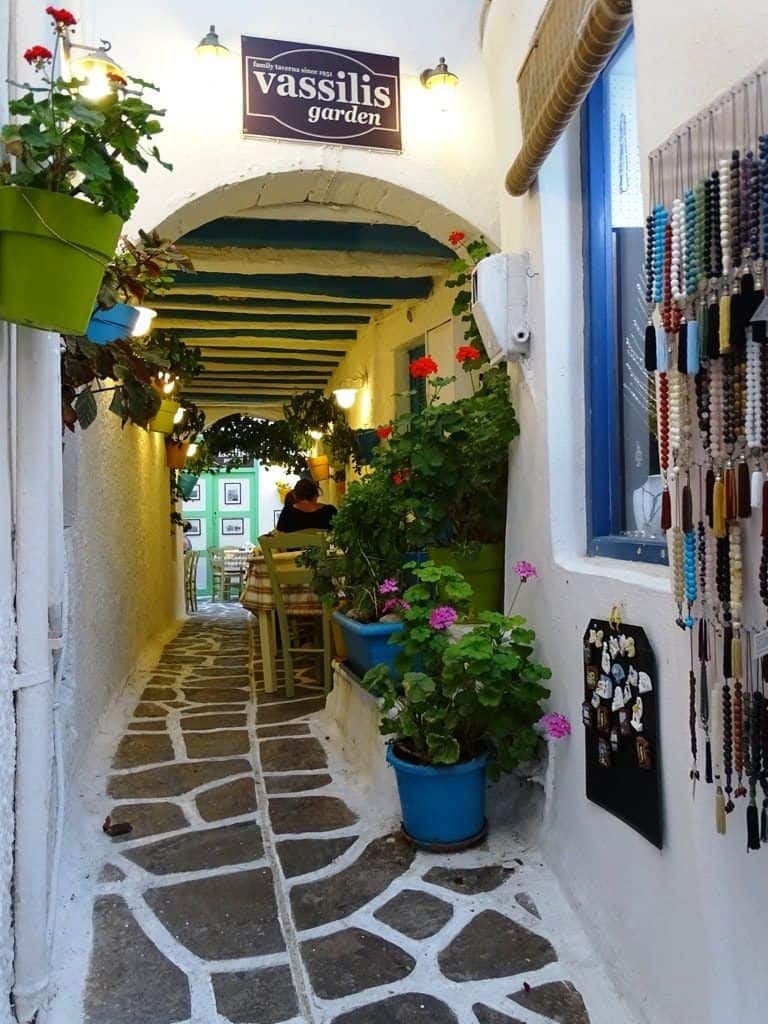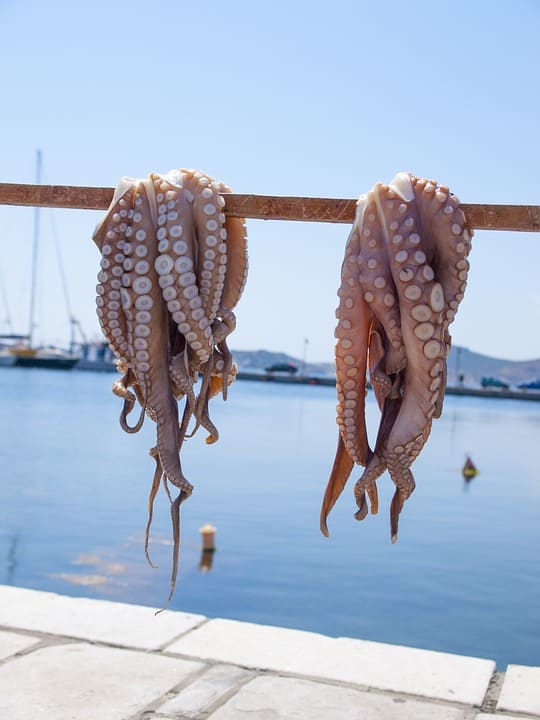
Naxos, Greece the Heart of the Aegean
By Gary Van Haas

Lush, green Naxos, is the largest and most fertile of the Cycladic islands and lies comfortably smack in the center of the Aegean.
It hosts magnificent green meadows with flowers running down to vast stretches of beaches, and cliffs that sink suddenly into the sea, rocky mountains side-by-side with fertile valleys, abundant springs, and streams.

These are just a few of the features on this large island and a spacious natural environment marked for its variety.
The coastline of Naxos is abrupt on the south side and more sheltered to the west, with numerous inlets and stunning white sandy beaches.
A Little History
The island was first heard of in the myths and then mentioned throughout every period of history, though it was at the peak of its glory during the ancient period of the Cycladic civilization.
Naxos port (or Hora) stands on a natural amphitheater situated on a hillside on the north-west side of the island making it one of the most attractive towns in the Cyclades.
As the visitor walks from the harbor you will find a variety of steps taking you high up towards the Venetian castle, where you will be struck by the beauty of the narrow winding lanes and the old stone houses lining the small back streets.
Interesting monuments from various periods are to be found all over the town, which includes fine Byzantine churches, the Castle itself (with its tower and battlements), and traces of Mycenaean buildings in the spot known as Grota.
The Archaeological Museum of Naxos has some notable exhibits and traces of Greek antiquity are to be found everywhere, and each part of this spectacular island has something to interest all travelers.
Another interesting little archaeological museum can be found in Apirathos where a number of strange Greek customs and habits have survived for millennia.

Naxos’ Villages
Koronos Village is 34 kilometers away from Naxos Town and it is one of the most beautiful and lesser known villages of Naxos Island.
It is a stepped village, scrabbling up two opposite mountainsides and it is renowned for its emery mines. Its pretty houses retain intact the traditional architecture and are divided into seven neighborhoods.
The central square is called “Platsa” and it the meeting point of the locals. Agia Marina (St. Marina) is the main church in Koronos village.
The older of the two aisles, built before 1200 AD was dedicated to Agios Ioannis (St. John) and the later one, dating to the 16th century, to Agia Marina.
The church features a marble iconostasis and it was renovated in 1747. On Agia Marina Day, on July 17, church icons are paraded around the village after mass and a big feast follows, lasting until the early morning hours of the following day.
Filoti is one of the most famous and beautiful villages of the island in the Tragea region, which is well-known for its olive groves and little Byzantine churches, both of which are also found in the village. Filoti’s name is ancient and believed to be of Ionian origin.
Even though today it is one village, it is in fact comprised of three smaller settlements Liri, Klefaro and Rachidi. The population totals about 1,800 which make it the largest village in numbers on Naxosl. The main street is the center of village life in terms of café and restaurants.
The little paved square named Gefyra (Greek – bridge), is surrounded by picturesque “kafeneons” (Greek traditional cafes) serving ouzo and snacks and a number of taverns and retail outlets, all shadowed by a huge, majestic plane tree allowing for a cool breeze.

Potamia is a traditional village set on a hillside overlooking a wonderfully lush and cool valley with a population of 300 inhabitants. It is dotted with monuments of Naxos’ rich history and its economic and cultural past, ranging from the Middle Ages onwards.
Water mills, chapels, and ruined towers are spread around the village and general area.
Each neighborhood hosts the ruins of one or two olive mills and the area still yields excellent wine, honey, herbs, and fruit. The unfinished archaic stone statue of Kore, a mythical female figure, is seen in the upper part of the village (called Ano Potamia), on the way to Halki (Chalki). Some distance away, on the way to the village of Melanes, you will find a male counterpart.
Potamia Castle on Naxos
The ruins of Potamia Castle (Greek – Apano Kastro), a small fort built by the Venetian Duke of Naxos Marco Sanudo in the 13th century as a lookout against pirate invasions, are seen on a hilltop on the way to Drymalia, the former municipality of eastern Naxos.
The most important of the 37 churches in the Potamia area is Agios Mamas, a 10th-century Byzantine basilica at Mitropoulos, on the road to Filoti.
The main source of income for the approximately 350 permanent residents of Potamia today is farming and livestock. The village is also well-reputed for its sweet preserves, excellent cheese variety, and local wine.
Note: Near the pretty coastal village of Apollonas – on the north side of the island, is a half-finished outsize marble kouros (statue of a youth), dating from the 6th century BC, still lying exposed in the marble quarry where it was abandoned.
Quaint Naxos Churches
Among some of the most interesting churches to see are Our Lady ‘Protothroni at Tragea and Our Lady of Filotitissa in the village of Filoti.

Agia Anna Village has woods of cedar surrounding the beautiful and exotic beach. Toward the end of the beach, there is a small jetty for small tourist and fishing boats to moor. Close to the small jetty, you will see the small church of Agia Anna and a bit farther down, the tiny Chapel of Agios Nicholaos.
The beach in front of this small church has fine-grained sand and is a great swimming spot.
Great Beaches on Naxos
Agia Anna Beach is situated at a distance of 6.3 kilometers south of the town of Naxos, just after Agios Prokopios. The settlement has been built along the coast, where the sand dunes used to be, and has recently expanded significantly.
Only a few inhabitants live there all year round since it has been mostly developed to cover the area’s high demand in tourist facilities. And it has done so very successfully.

Several alternatives for accommodation are available in the village. Food and beverage are good at the numerous sea front taverns, all with a view of the somewhat exotic landscape. There are also beach bars where the swimmers can enjoy cool drinks.
Swimming, sunbathing and sea sports are available at the well-organized beach that consists of fine sand and the crystal clear sea lapping the village.
You may also be tempted to go to the neighboring sandy beach of Maragas.
If you are around on the 25th of July, don’t miss taking part in the local religious feast (called panegyri) in honor of Agia Anna (St. Anna).
Access to the beach is very easy from Naxos Town. You have a choice of frequently running public buses, taxi services, rented or private car and motorbikes. If you choose to go by yacht or boat, the small jetty there has a suitable mooring.
Prokopios Beach, Naxos
Many tourists choose to get there, from the nearby settlements of Agios Prokopios and Plaka, on foot. It is a quite short and very beautiful coastline walk worth taking.
| Read Gary’s story about Delphi, Greece |
Prokopios Beach is situated some 5.7 kilometers from the town of Naxos and is located at the centre of the western coast of the island, in a lovely natural environment along three salt pans, which also offers an excellent view both of the inland landscape and the sea.
Visitors have many alternatives for accommodation and there are a variety of lodgings on offer along the beach.
Here you can also visit the many taverns, cafés, and bars with popular music, most of which are on the shore.
Apart from the lovely view, the beach of Prokopios is one of the best-organized beaches of the island where thick, coarse sand and crystal clear turquoise seas complete the picture. It is excellent for swimming, sunbathing and sea sports. The younger generation has made this beach one of their favorites.
You may want to visit the village of Agios Prokopios, up the hill with its tiny chapel as well as the tourist resort of Stelida which is close to where this church is situated.
If you are still in the area during the first days of July, make an effort to attend the local religious feast in honor of Agios Prokopios, which takes place on the 8th of July.
Access to and from here is easy with frequent public buses and by taxi. You may also choose to rent a car or motorbike. Emergencies can be handled at the corresponding services in Naxos town.
If you’re ready to hit the water, there are other good swimming beaches at Mikri Vigla, Kastraki, Alikos, Pirgaki, Agiassos (on the west side), Apollonas, Psili Amos, Panormos and Pahia Amos.
The superb beaches of Naxos are attractive as its villages and its wealth of monuments draw thousands of visitors to the island each year, with plenty of tourist amenities in town, which make Naxos easy to tour around and see the charms of this vast remarkable island.

TRAVEL TIPS
Getting there:
By ferry from Piraeus
There are many Car Ferries to choose from going to Naxos all year and for information: contact the Piraeus Port Authority, tel.: 210 455-0000
By ferry from Rafina
Call for Ferry information at Rafina Port Authority, tel.: 2294 023605
Useful telephone numbers:
Police: 2285 22100
Municipal Offices: 2285 22717
Port Authority: 2285 22300
Archaeological Museum: 2285 22725
 Gary Van Haas worked for many years as a feature writer for The Athens News, International Herald Tribune, New York Times, Los Angeles Times, Time and Newsweek Magazines. His books can be found on Amazon.com.
Gary Van Haas worked for many years as a feature writer for The Athens News, International Herald Tribune, New York Times, Los Angeles Times, Time and Newsweek Magazines. His books can be found on Amazon.com.
- Camino Tales: Wine and Memories in Galicia, Spain - July 25, 2024
- Beluga Hunting in Norway - July 20, 2024
- Costa Rica: A Rainforest Chocolate Tour - July 18, 2024






Thanks for sharing. really very nice article. Amazing Place to enjoy Holidays .